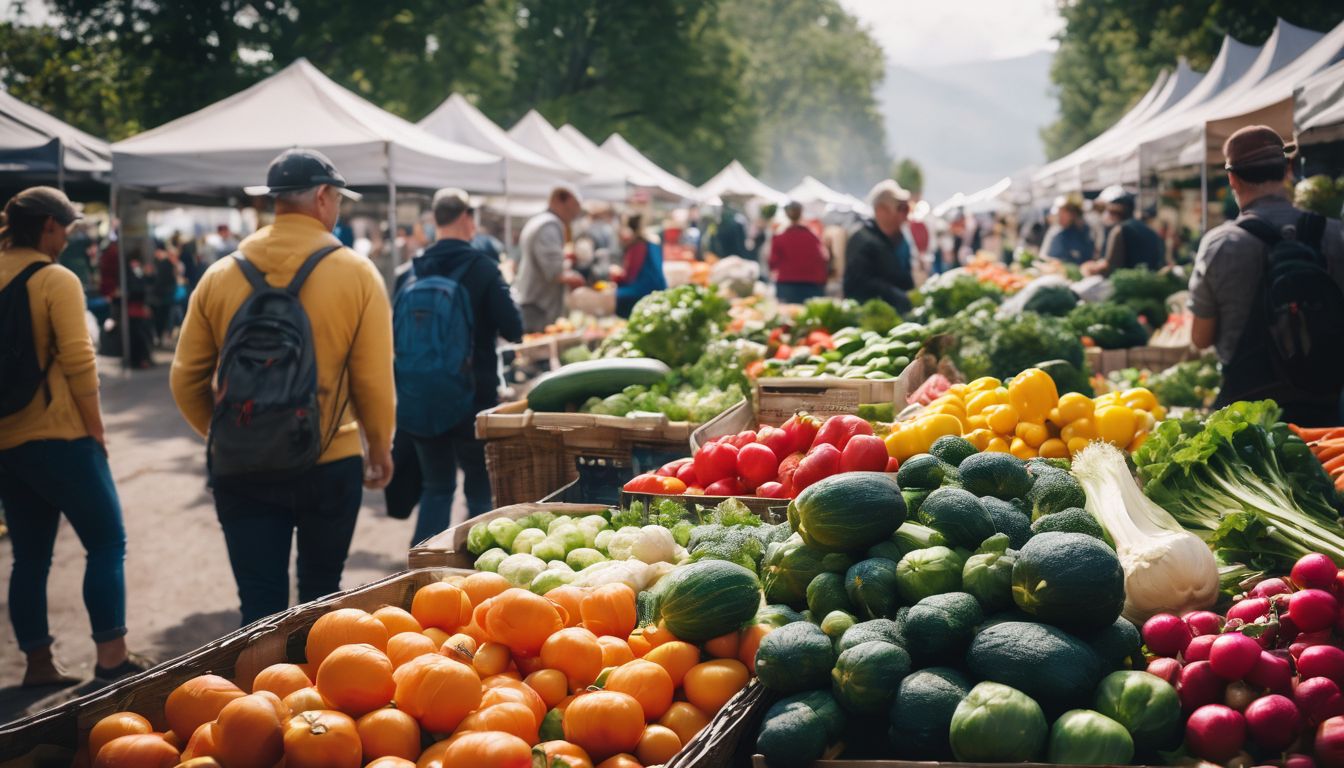We’re all too familiar with that nagging sense of guilt as we watch the mountain of packaging waste grow, aren’t we? Sharing in your consternation, we’ve rolled up our sleeves and have scoured every nook and cranny for eco-friendly packaging alternatives.
Our explorations have unearthed some truly revolutionary solutions that shine a light on plant-based wonders and clever designs poised to shrink our environmental footprint significantly.
Let’s embrace this journey towards sustainability together, shall we? The future looks brighter when we tread lightly on our precious planet.
Key Takeaways
- Eco-friendly packaging reduces the reliance on non-renewable resources and helps cut down pollution by utilising materials like plant-based plastics that naturally break down.
- Sustainable design innovations, such as mushroom – based and edible packaging, along with closed loop systems, are leading the way in minimising waste and promoting circular economies.
- Challenges of adopting sustainable packaging include higher costs and a need for increased consumer education, but solutions involve technological advancements and infrastructural investment to improve recycling processes.
- Traceability solutions like RFID tags ensure transparency within supply chains, allowing consumers to make informed decisions about the environmental impact of their purchases.
- Engaging in educational campaigns, supporting businesses that focus on sustainability, and advocating for eco-friendly products can drive the shift towards more sustainable packaging practices.
Understanding Conventional Packaging
Conventional packaging has a significant environmental impact due to its use of non-biodegradable materials and the challenges of recycling and waste management. This outdated approach poses negative consequences for the environment, and it’s important to understand these issues in order to seek sustainable solutions.
Environmental Impact
Every piece of conventional packaging we toss away takes a toll on our planet. Plastics and other non-biodegradable materials pile up in landfills, oceans, and ecosystems, threatening wildlife and spreading toxins.
Our reliance on fossil fuels to produce these materials releases greenhouse gases that contribute to climate change. It’s clear we must transition to eco-friendly packaging solutions that protect the environment.
We’re stepping up as conscious consumers by choosing green packaging for our products. By opting for biodegradable packaging made from renewable materials, we reduce waste and cut down on pollution.
This shift not only preserves natural resources but also bolsters brand reputation among individuals who value environmental conservation. Embracing sustainable solutions is key in revolutionising consumer goods for a healthier Earth.
Negative Consequences
Conventional packaging has detrimental effects on the environment. It contributes to pollution, deforestation, and greenhouse gas emissions. Moreover, the production and disposal of non-sustainable packaging materials contribute significantly to land and water pollution.
Plastic waste from packaging also poses a threat to marine wildlife as it takes hundreds of years to decompose. Essentially, the negative consequences of conventional packaging resonate across various ecosystems and are harmful at every stage.
Manufacturing conventional packaging relies heavily on non-renewable resources like fossil fuels, leading to higher energy consumption and carbon emissions. This results in air pollution which greatly impacts human health and biodiversity.
Challenges of Recycling and Waste Management
Implementing effective recycling and waste management systems poses significant challenges. Sorting and separating various materials for recycling demands labour-intensive processes, while contamination from non-recyclable items complicates the reprocessing of materials.
Limited infrastructure and resources often hinder efficient collection and disposal of waste, leading to a high volume of unrecycled or improperly disposed materials. In addition, educating communities on proper recycling practices is an ongoing challenge due to diverse interpretations of what can be recycled and regional differences in available recycling facilities.
Creating awareness about the benefits of sustainable packaging options requires targeted educational campaigns. Encouraging behavioural changes towards responsible consumption and waste reduction remains crucial for overcoming these challenges.
Sustainable Packaging Solutions
Innovative, biodegradable and compostable materials are being developed to replace conventional packaging, reducing negative environmental impact. Design innovations focus on closed loop systems that promote sustainability and minimal waste.
Biodegradable and Compostable Materials
Biodegradable and compostable materials offer sustainable alternatives to traditional packaging. These materials break down naturally, without leaving behind harmful residues or contributing to environmental pollution.
Utilising biodegradable and compostable packaging aligns with ecoconscious consumers’ values, promoting responsible consumption and waste reduction. By embracing these green innovations, consumer goods businesses can significantly reduce their environmental impact while meeting the demands of environmentally conscious individuals.
Innovations in design have enabled the development of biodegradable and compostable packaging solutions that are both functional and environmentally friendly. From food supply chains to everyday consumer products, the adoption of these earth-friendly packaging options represents a positive step towards greening supply chains and supporting sustainable consumer goods.
Innovations in Design
Transitioning from biodegradable and compostable materials, let’s explore the latest innovations in design for eco-friendly packaging. One exciting advancement is the use of sustainable and renewable materials such as mushroom-based packaging, which is not only biodegradable but also offers protective properties.
Another notable innovation involves incorporating edible packaging made from seaweed or other food-grade materials, reducing waste while providing a unique consumer experience. Moreover, advancements in 3D printing technology enable the creation of custom-fit packaging, minimising material usage and optimising space during transportation.
These innovative designs demonstrate a commitment to environmentally friendly packaging solutions that are both practical and planet-conscious.
In addition to these breakthroughs, sustainable design principles have led to the development of reusable and refillable packaging systems that promote circular economies. Furthermore, smart packaging technologies utilising RFID tags and QR codes enhance traceability throughout the supply chain, ensuring transparency and accountability in environmental efforts.
Closed Loop Systems
Closed loop systems are a sustainable packaging solution that promotes circularity by reducing waste and conserving resources. In this system, materials are recycled and reused to create new products, minimising the need for raw materials and decreasing environmental impact.
Companies implementing closed loop systems contribute to a more eco-friendly production cycle while addressing concerns about resource depletion and waste generation.
Transitioning to closed loop systems requires collaboration across supply chains, technological advancements in material recovery, and consumer engagement. As businesses embrace this approach, they can significantly reduce their carbon footprint and support the conservation of natural resources for future generations.
Implementation in Food Supply Chains
Assessing environmental footprints and designing for efficiency and minimalism are crucial steps in embracing biodegradable packaging in food supply chains. Dive deeper into the sustainable solutions that are revolutionising consumer goods by reading more on our blog.
Assessing Environmental Footprints
When evaluating environmental footprints, we consider the lifecycle of packaging materials. We measure the energy used in production, transportation, and disposal. Assessing carbon emissions and water usage is crucial to understand the impact on the environment.
By examining the entire supply chain, we can identify areas for improvement and make informed decisions about sustainable packaging solutions. Understanding environmental footprints empowers us to embrace eco-conscious choices for a greener future.
Designing for Efficiency and Minimalism
- Streamlining packaging design to reduce material usage and waste.
- Utilising lightweight materials and optimising shapes to minimise transportation emissions.
- Incorporating modular designs to maximise space utilisation and reduce packaging volumes.
- Embracing package – free alternatives to eliminate unnecessary materials.
Embracing Biodegradable Packaging
As we transition towards embracing biodegradable packaging, we take a significant step in reducing our environmental footprint. Biodegradable materials such as plant-based plastics and natural fibers offer a sustainable alternative to conventional packaging.
These eco-friendly solutions break down naturally over time, mitigating the harmful effects of traditional packaging on the environment. By adopting biodegradable packaging, we contribute to green living and support conservation efforts whilst reducing our reliance on non-renewable resources.
Furthermore, with the increasing demand for earth-friendly products, embracing biodegradable packaging becomes imperative for businesses aiming to resonate with eco-conscious consumers.
Benefits, Challenges, and Future Outlook
Implementing sustainable packaging solutions brings numerous benefits, such as reducing environmental impact and meeting consumer demand for eco-friendly products. However, challenges like cost and infrastructure changes need to be addressed in order to fully adopt these practices in the future.
Consumer Awareness and Education
Consumers play a crucial role in driving change towards sustainable packaging. By educating ourselves about eco-friendly solutions and understanding the environmental effects of conventional packaging, we can make informed choices that support conservation efforts.
Taking steps to seek out and choose ecoconscious packaging and products, such as recyclable or biodegradable options, empowers us to contribute positively to the environment.
Embracing consumer awareness also involves advocating for traceability solutions and promoting earthfriendly packaging within our communities. By being proactive in seeking out information and supporting businesses that prioritise sustainability, we can collectively drive a shift towards eco-friendly practices in consumer goods.
Traceability Solutions
Sustainable packaging relies on traceability solutions to ensure the authenticity and sustainability of materials used. This involves tracking every step of the supply chain, from sourcing raw materials to production and distribution.
By incorporating technology like blockchain and RFID tags, we can accurately monitor the environmental impact of packaging materials, ensuring that they meet eco-friendly standards.
Furthermore, traceability solutions enable consumers to make informed choices by providing transparent information about the origins and lifecycle of products, empowering them to support sustainable practices in consumer goods.
Implementing traceability solutions necessitates collaboration among stakeholders across the supply chain, from manufacturers to retailers. Additionally, regulatory bodies play a crucial role in setting industry standards for transparency and accountability.
Overall Impact on the Environment
Eco-friendly packaging has a positive impact on the environment by reducing carbon emissions, conserving natural resources, and minimising waste. Recyclable packaging materials help to lower energy consumption and greenhouse gas emissions, contributing to a healthier planet.
Embracing sustainable packaging solutions promotes biodiversity conservation and protects ecosystems, ensuring a more sustainable future for generations to come.
Implementing eco-friendly practices in packaging design reduces pollution, minimises environmental degradation, and safeguards wildlife habitats. By choosing biodegradable and compostable materials for consumer goods, we can significantly reduce the amount of plastic waste that ends up in landfills or oceans.
Barriers and Solutions for Adoption of Sustainable Packaging.
Adopting sustainable packaging can pose challenges, but there are solutions to overcome them. Here are some key barriers and their corresponding solutions for adopting eco-friendly packaging:
- Limited availability of sustainable materials: Many companies face difficulty in sourcing biodegradable or compostable materials for their packaging needs, but the solution lies in investing in research and development to create new eco-friendly alternatives.
- Higher production costs: The initial investment in sustainable packaging may be higher, but long-term cost savings can be achieved through innovations in design and manufacturing processes.
- Consumer education and awareness: Lack of understanding about the importance of eco-friendly packaging amongst consumers is a barrier, which can be addressed through educational campaigns and transparent labelling.
- Infrastructure for recycling and waste management: Insufficient infrastructure for collecting and processing biodegradable materials is a challenge, but investment in recycling facilities and collaboration with waste management companies can provide solutions.
- Regulatory barriers: Inconsistent regulations around sustainable packaging pose challenges, but advocacy for standardisation and engaging with policymakers can drive change.
- Resistance to change within the industry: Traditional mindsets hinder the adoption of sustainable practices, however, fostering a culture of innovation and sustainability within organisations can break down these barriers.
Conclusion
In conclusion, sustainable packaging solutions are transforming the way consumer goods are packaged. The shift towards eco-friendly materials and innovative designs is reducing environmental impact and fostering a more responsible approach to consumption.
Embracing these changes will lead to a brighter future for our planet. It’s time for all of us to take an active role in supporting these initiatives and making a positive difference.
FAQs
1. What is eco-friendly packaging?
Eco-friendly packaging refers to solutions for wrapping and protecting products that cause minimal harm to the environment.
2. How does eco-friendly packaging benefit the planet?
Using eco-friendly materials reduces waste, conserves natural resources, and cuts down on pollution, helping keep our planet healthy.
3. Can consumer goods companies switch to eco-friendly packaging easily?
Yes, many companies are now adopting eco-friendly solutions that can replace traditional materials without much hassle.
4. Do customers prefer products with eco-friendly packaging?
Absolutely! A growing number of consumers choose products with green packaging because they want to make environmentally responsible choices.





